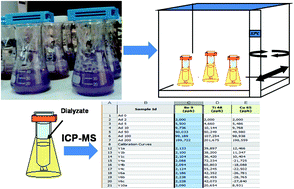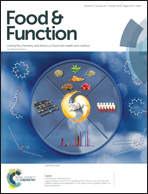In vitro human bioavailability of major, trace and ultra-trace elements in Chilean ‘natural’ wines from Itata Valley†
Abstract
In vitro human bioavailability of elements in ‘natural’ wines from Chile's Itata Valley has been assessed using an in vitro dialyzability approach. The red wines (fifteen samples) were of the Cinsault, Cabernet sauvignon, Carmènére, Malbec, and Pinot noir varieties. All white wines (three samples) were of the Muscat of Alexandria variety. Inductively coupled plasma-mass spectrometry was used for determination. Elements such as Ag, As, Be, Cd, Cr, Hg, Mo, Ni, Pb, Sb, Se, Sn, Ti, Tl, and V were not found to be bioavailable (concentrations lower than the limit of detection in the dialysates). Elements such as Al, Co, and Fe showed low bioavailability ratios (lower than 20%), whereas B, K, Li, Mg, and Mn were found to be of moderate bioavailability (bioavailability ratios within the 20–79% range for most wine samples). Ca, Cu, and Sr bioavailability was moderate (higher than 20%) in some wines, but most of the samples showed Ca, Cu, and Sr bioavailabilty ratios lower than 20%. No differences were found regarding bioavailability ratios among red and white wines, or among the grape varieties.



 Please wait while we load your content...
Please wait while we load your content...